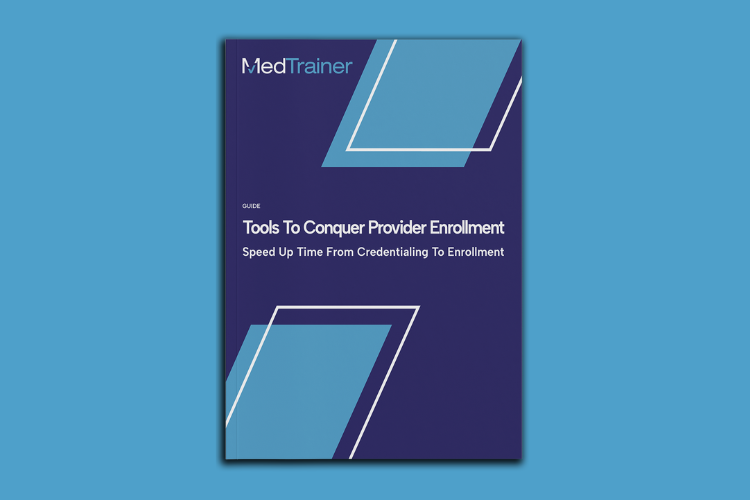Dental credentialing can significantly impact your practices’ expansion and operational efficiency. As the practice adds new dentists to the team, each must undergo the credentialing process to be recognized by insurance networks, which is often time-consuming and can delay the time it takes for new dentists to start seeing patients.
Managing these complexities effectively is essential for the practice’s success and requires a robust administrative system or dedicated credentialing staff to handle the increased workload and ensure that all professionals are properly credentialed and ready to deliver care.
Medical Credentialing vs. Dental Credentialing
The credentialing process is fundamentally the same, regardless of whether it is a medical or dental provider. Below is a chart showing the main differences between medical and dental credentialing.
| Medical Credentialing | Dental Credentialing |
| Covers a wide range of specialties and procedures | Covers a much smaller list of specialties and procedures |
| Credentialing usually takes 90-120 days | Credentialing usually takes between 30-45 days |
| Medical fee scale changes based on procedure/service | Dental fee scale changes based on the specialty |
| Payer representatives are usually available via phone | It can be a challenge to reach payers — some more than others |
| Medicare reimburses for a vast amount of visits and procedures | Medicare only covers more extensive dental services that impact Medicare covered services |
Steps To Complete Dental Credentialing
Below are the general steps involved in completing dental credentialing. If you’re familiar with medical credentialing, you’ll notice they look very familiar.
- Set Up Online Portals: Ensure the dentist’s CAQH profile is up-to-date. Some payers, such as Aetna, require CAQH credentialing. If the dentist is being credentialed in a state with its own portal, set that up as well.
- Primary Source Verification: Primary source verification involves contacting original sources — such as educational institutions, licensing boards, and certification bodies — to confirm the authenticity and accuracy of the documents and qualifications provided by the provider. Every dental payer may have their own specific requirements.
- Work History and Reference Checks: To assess the dentist’s experience and reputation within the healthcare community, the work history must be verified without any gaps longer than 30 days.
- Background Checks: Comprehensive background checks help rule out any criminal history, malpractice claims, disciplinary actions, or other records that might send up red flags.
- Payer Enrollment: Dentists must be enrolled with every payer they accept insurance from — again, before they start seeing patients. With an average of 5 – 10 payers per provider, this can be a time-consuming and tedious step that needs to start early in the credentialing process.

Get the tools you need to eliminate delays in your provider enrollment process.
Tips To Speed Up Dental Credentialing
The time it takes to credential dentists can vary depending on a variety of factors. Generally speaking, you should plan for several weeks at a minimum to complete the credentialing process from start to finish. The exact timeline depends heavily on the dentist’s specialty, volume of dentists, and the efficiency and completeness of the documentation provided.
1. Start as soon as the dentist is hired.
Make sure you start collecting documents as soon as possible so you’re aware of any red flags or complications early in the hiring and onboarding process.
2. Make it easy for dentists to submit documents.
It is much easier for you and your new hire, to request digital documents as opposed to collecting a paper credentialing packet. Credentialing software offers the ability for dentists to securely submit documents to an online portal.
3. Set a process specific to your organization’s payers.
Payers, such as Delta Dental and Cigna, all have specific requirements for the state in which they are located. Understanding this process and creating checklists for each payer will help you to complete dental credentialing much more quickly. A credentialing workflow ensures continuity in case the credentialing expert is out of the office or has moved on.
4. Set reminders and notifications.
Scheduling reminders for follow-ups can help you shave hours or weeks off your credentialing process. There’s likely to be a lot of back-and-forth in verifying information, so be sure to schedule reminders every time there’s an additional step required to complete the action. Credentialing software can automate these reminders to ensure you don’t miss steps or deadlines.
Dental Payers To Consider Enrolling With
The insurers that you enroll with can have a big impact on the patients who come to your office. It can also have a big impact on your revenue. Here are some of the nation’s largest dental insurers.
- Delta Dental: The largest dental insurer in the US. Their network includes over 150,000 participating dentists nationwide.
- UnitedHealthcare: One of the largest medical insurers that also offers dental plans.
- Aetna: A large dental insurer that boasts access to millions of members and helpful office tools.
- Cigna: Global health services company that provides dental insurance plans to millions of members.
- Humana: One of the nation’s largest dental benefits companies serving nearly 8 million members.
- MetLife: A provider of dental plan administration for more than 21 million people.
- Blue Cross Blue Shield (BCBS): Association of 33 independent BCBS companies offering dental plans in all 50 states.
Keep Dental Credentialing Organized
Using dental credentialing software can keep your staff and dentists on track for a quick enrollment.
- Data To Improve Processes: Quickly assess and improve your enrollment process with all credentialing data in one place with customizable dashboards.
- Built-In Automation: Keep dental credentialing moving forward with automated reminders for providers to send documents, notification of recredentialing deadlines, and license expiration.
- CAQH Profile Management: Streamline your processes with the most up-to-date information at your fingertips.
- Actionable Enrollment Workflows: Simplify enrollment processing with a customized workflow, including a process checklist with embedded notes and task assignments.
If your growing dental organization needs more than just credentialing software, consider working with a credentialing service, such as MedTrainer. Geographically-focused credentialing specialists know the rules and regulations for each payer and state. In many cases they have also developed good working relationships with the payers, which can smooth the process.
